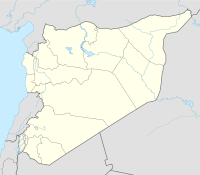Minet el-Beida
Appearance
المينا البيضا | |
 Duck container found at Minet el-Beida. | |
| Alternative name | Ma'hadu |
|---|---|
| Location | Latakia, Syria |
| Type | settlement, port |
| History | |
| Founded | late fifteenth century BC |
| Periods | Bronze Age |
| Cultures | Canaanite |
| Satellite of | Ugarit |
| Events | Bronze Age collapse |
| Site notes | |
| Excavation dates | 1928—1935 |
| Archaeologists | Claude F. A. Schaeffer |
| Ownership | Public |
| Public access | No |
| Ugarit |
|---|
 |
| Places |
| Kings |
| Culture |
| Texts |
Minet el-Beida (Template:Lang-ar, The White Harbor; or ancient Ma'hadu) is a small bay located 10 kilometers (6.2 mi) north of Latakia, Syria on the Mediterranean Sea. [1] It is an important archaeological site because it served as the harbor town and necropolis for Ugarit.
See also
References
- ^ Michael C. Astour, Ma'Hadu, the Harbor of Ugarit, Journal of the Economic and Social History of the Orient, vol. 13, iss. 1, pp. 113 – 127, 1970
Bibliography
- Watson, Wilfred G. E.; Wyatt, Nicolas (1999). Handbook of Ugaritic studies, Part 1, Volume 39. BRILL. ISBN 978-90-04-10988-9.
- Younger, K. Lawson (2007). Ugarit at Seventy-Five. EISENBRAUNS. ISBN 978-1-57506-143-6.
- Gates, Charles (2003). Ancient cities: the archaeology of urban life in the Ancient Near East and Egypt, Greece and Rome. Routledge. ISBN 978-0-415-12182-8.
- Hansen, Mogens Herman (2000). A comparative study of thirty city-state cultures: an investigation. Kgl. Danske Videnskabernes Selskab. ISBN 978-87-7876-177-4.

